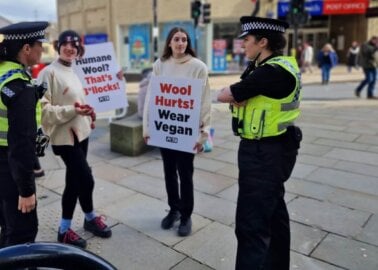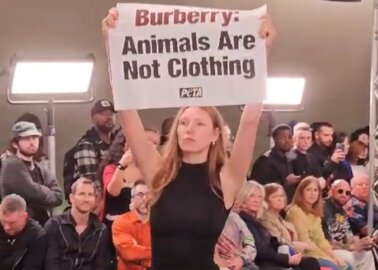Why Did We Send Three ‘Bruised and Bloodied’ Models to the Opening of British Wool Week?
Our protest in central London today highlighted the wool industry’s dark side.

Three PETA supporters turned up to the opening of Wool Week, made up to look bruised, beaten, and bloody – resembling many sheep after they’ve been kicked, punched, and cut by shearers.

One of them also held a replica of a dead lamb to represent the animals who don’t survive this violent, traumatic process or who are slaughtered after a few years of wool production.
Multiple exposés of shearing sheds around the world have revealed that sheep are left with bloody wounds and broken limbs after being roughly handled by unskilled farm labourers who are paid to work as quickly as possible. And on some farms in South America – including those linked to UK companies or which claim to sell “responsibly sourced” wool – fully conscious sheep’s throats were slit and they were even skinned while they were still alive.

Closer to home, sheep in Britain also suffer. Huge numbers of lambs and ewes die from hypothermia or malnutrition each year out on exposed hilltops. Lambs’ tails are routinely cut off, and males are often castrated without painkillers by having tight rubber rings put over their scrotums so that their genitals slowly wither from lack of blood.
Just like the fur, angora, and other global industries that trade in animals’ fur and skins, the wool industry treats gentle, sensitive sheep as disposable commodities – raising them as cheaply as possible, then sending them to be slaughtered as soon as they’re no longer profitable.
We don’t need to wear wool. There are now many cosy vegan fabrics available to keep us warm through the winter that don’t involve harming any animals.
When you’re out shopping for your winter wardrobe, please check the label and choose clothes that don’t contain wool.



